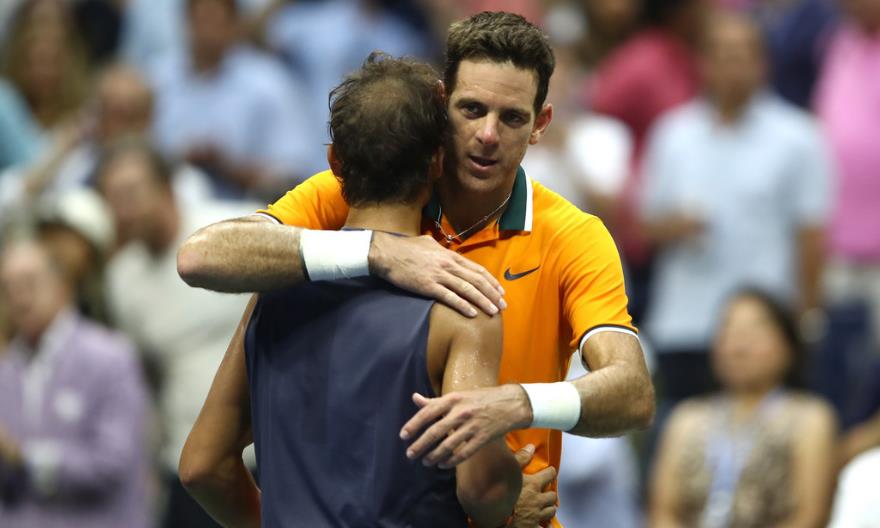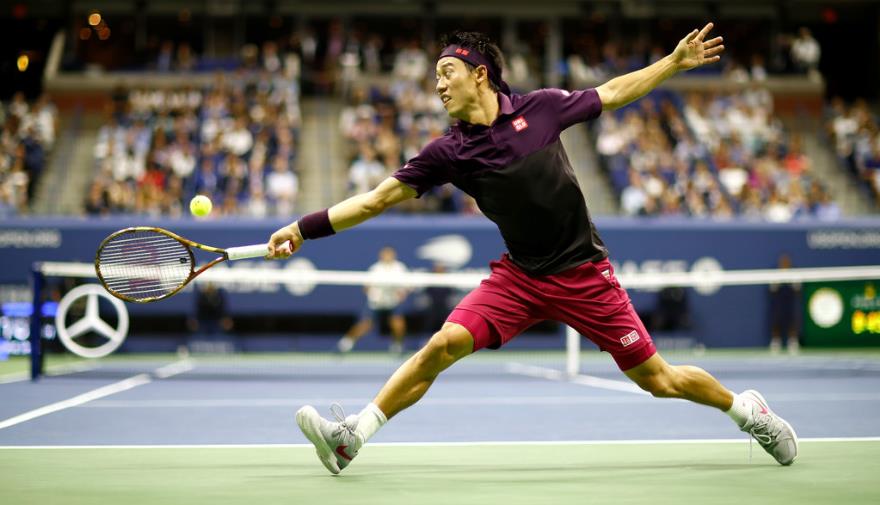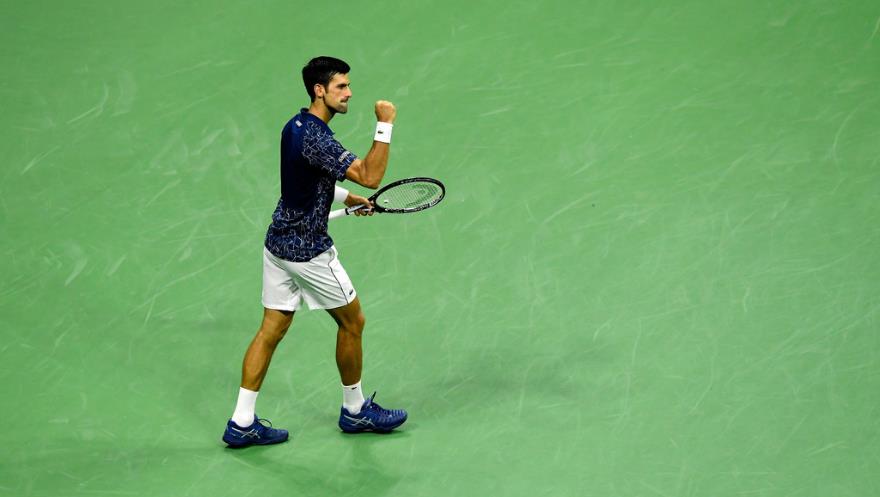Friday’s men’s semifinal matches did not provide the thrill that many were hoping for but at the end of the day, Juan Martin del Potro and Novak Djokovic advanced to Sunday’s final probably because they managed in the best possible way the physical challenges presented to them throughout the two weeks. What that means is open to interpretation and enough has been written about those challenges throughout the tournament. Rehashing them falls beyond the scope of this piece which includes on a round-up of the two matches played on Friday, as well as an early look ahead to Sunday.
Rafa never had a chance, or did he?
Rafael Nadal and Juan Martin del Potro were the first ones to step inside Arthur Ashe stadium. They had a memorable quarterfinal encounter at Wimbledon, one of the best matches of 2018 so far. Del Potro came into this match serving extremely well and spent around three and a half hours less time on the court on his way to the semifinals than Nadal did on his. Nadal took four hours and 49 minutes to overcome Dominic Thiem in a terrific quarterfinal match that went to a fifth-set tiebreaker and featured grueling baseline rallies, while Del Potro eliminated John Isner in three hours and 31 minutes earlier on that same day, in a match dominated by short rallies and big serves. In a tournament marked by retirements and physical ailments, it did not come as a surprise that one area of concern was whether or not Nadal could continue to put forth the best version of himself for one more match, if not two.
We did not have to wait long for the answer. It became clear to the naked eye, by the early moments of the second set, that Rafa’s knee was not going to allow him to finish the match. He confirmed that much himself when he was down 1-4 in the second set during an argument with the umpire, telling him that he is “gonna retire anyway.” He did four games later, when Del Potro won the second set 6-2 to take a two-set lead.

That should not take away any credit from Del Potro who showed the resolve to get past a great deal of dismay stemming from a significant collapse when he served for the first set at 5-4. At 40-30, on his first set point, he sailed a backhand cross-court winner attempt wide. It was on a short sitter hit by Nadal and Del Potro should not have missed it since he got to strike the backhand from about a meter behind the service line.
He earned a second set point after drilling a backhand down-the-line winner at deuce. He hit a big serve to set it up perfectly for his classic 1-2 punch execution. Rafa returned the ball short and high, allowing Del Potro to move inside the baseline for his trademark forehand bazooka winner. He dumped it into the net! In the ensuing deuce point, he missed a similar forehand, long this time, giving Nadal a break-point opportunity. Juan Martin completed the collapse when he landed another backhand sitter into the net to lose his serve.
His body language appeared deflated when he lost the next game in four relatively quick points and went down 5-6. Things appeared to go from bad to worse when he began that game with a first serve that he thought landed out, and stopped playing. Rafa’s return went in and he was awarded the point. Juan Martin challenged his own service call, a rare occurrence, hoping that it was out. The replay confirmed that it caught the line and he was down 0-15. At that point, Del Potro had lost eight points in a row, going from a set point up to being down 5-6, 0-15, in a string of points lost in the most deflating ways possible. He managed to get to 30-30, largely thanks to a couple of solid first serves.
Now, it was Nadal’s turn to squander a golden opportunity. With the momentum completely on his side and his opponent in a mentally fragile state, he had a look at a second serve on the 30-30 point. He hit a superb return to the baseline that forced Del Potro into responding with a defensive backhand while leaning on his backfoot. It landed short and Rafa had a perfectly aligned forehand inside the baseline and in the middle of the court. He had a choice of either corner for the routine forehand winner or even a drop shot since Del Potro was three meters behind the baseline. Rafa has hit thousands of winners from that position routinely, in practice or in matches.
Yet, he hit a fair-paced topspin approach shot that bounced a bit past the service line, one that was not even placed to the corner. Furthermore, he chose to hit it to Del Potro’s forehand side.
The Argentine took two quick steps to his right and struck a forehand down-the-line passing shot that landed on the line. Rafa should have been up a set point, but instead, found himself down 40-30. He then committed a backhand unforced error which brought forth the tiebreaker.
That represented the last key moment of the match as Del Potro, with renewed energy, raised his level to win the tiebreaker. From that point forward until Rafa’s retirement at the end of the second set, the Argentine’s level never dropped. He only committed three unforced errors during that part, whereas he committed 15 of them prior to the tiebreaker. Nadal’s movement appeared visibly diminished from the early portion of the second set forward. Frankly, I was surprised that he even waited until the end of the set to retire.
While Del Potro would have certainly preferred to earn the victory with a full-length match and was concerned for Rafa’s health, I have little doubt that he is delighted deep inside to get past Nadal in two sets and in barely over two hours. After all, he will undoubtedly need every ounce of energy in his tank for a chance to beat an in-form Novak Djokovic and lift the trophy on Sunday.
Novak is unstoppable, or is he?
Well, the answer to the above subtitle is a lot less ambiguous than the answer to the previous one. He certainly appears unstoppable. Djokovic is playing stellar tennis, moving faster, rallying more consistently, hitting deeper, and without a doubt, returning better than anyone. It’s true that Nishikori’s forehand did not get off the gates as quickly as the rest of his game did when the match began, thus facilitating the early-lead jump start by Novak. Yes, it’s also true that Kei missed some makeable returns here and there that could have given him a chance to sink his teeth into the second set. Then what? Would it have made a difference?
Even if Kei’s forehands were on fire, can anyone comfortably say that it would have been enough for him to mount a lead against this version of Novak? Could he have strung together three such sets to score the upset? It would push the boundaries of plausibility to expect Nishikori to perform at that level for three sets. For about three and a half games early in the second set he did, and that still included a game (first of the second) in which he had to bust his rear end for thirteen minutes and save four break points, just to hold serve.

You want to see how fast Novak was moving? Watch the 15-15 point at 1-1 in the second set for one example among many.
You want to see how many outrageous shots Kei had to produce at times to win a point? See the first point of the 3-2 game in the second set as one example.
You want to see how well Novak returned? Watch just about any of Kei’s service games, including the ones where he produced some first serves on the line. Djokovic would just lunge and send back a deep rocket-shot, forcing Nishikori to take steps back instead of setting up the 1-2-punch combination that he loves. And heavens forbid if Kei missed a first serve. Novak would then move into the court and launch his attack immediately.
In any case, on Friday night, there was no uncertainty as to who the better player on the court was for two hours and 22 minutes. Djokovic secured a 6-3 6-4 6-2 victory and reached his eighth US Open final, tying the record held by Ivan Lendl and Pete Sampras.

Looking ahead to Sunday
On paper, this is an appetizing menu for tennis fans.
On the one hand, a beloved player, who overcame multiple injuries and extended lay-offs from the sport, will make his first reappearance in the final of a Major in nine years, on the same venue where he won his only Major title in 2009. On the other hand, you have one of the best players in the history of our game, a phenomenal athlete who recently recovered himself from a grave injury and rediscovered his form so quickly that he is now in a position – or, even favored – to win his second Major title in a row, his fourteenth overall.
By Sunday afternoon, both players should feel fresh and ready to click on all cylinders. The weather will be a relevant factor in that a chance of rain may force the roof to be closed. As to whom that benefits, I am ready to be convinced by anyone who can provide a valid argument for one player or the other.
Otherwise, I can only confirm a couple of things per player. Del Potro must keep his first-serve percentage high to collect free points, as he has done all tournament (except on Friday against Nadal). He must also find a way to deal with Novak’s depth on ground strokes because he cannot be the one scrambling and defending in extended baseline rallies.
Djokovic, for his part, must continue to return explosively as he has all tournament because Del Potro frequently relies on the 1-2 punch following first serves. Let’s not forget that, as well as he may have returned so far, Novak has yet to face a power server of Del Potro’s caliber in the tournament. He must also keep Juan Martin on the move because the big Argentine’s striking power is in direct correlation with how well he sets up his lower body. The classic triangle-rally is also an option for Novak who can, if he chooses to use it, exclusively work Del Potro’s backhand side until he gets a short ball, at which point he can pick his target and end the point with a winner.
Until Sunday…
